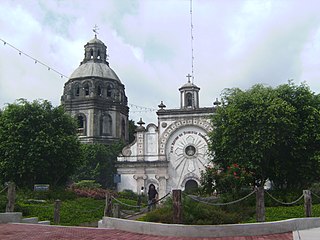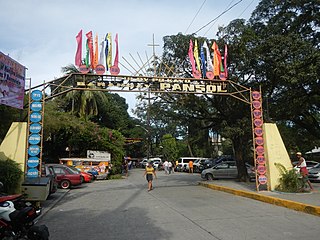
Manila, officially the City of Manila, is the capital and second-most populous city of the Philippines. Located on the eastern shore of Manila Bay on the island of Luzon, it is classified as a highly urbanized city. As of 2019, it is the world's most densely populated city proper. It was the first chartered city in the country, and was designated as such by the Philippine Commission Act No. 183 on July 31, 1901. It became autonomous with the passage of Republic Act No. 409, "The Revised Charter of the City of Manila", on June 18, 1949. Manila is considered to be part of the world's original set of global cities because its commercial networks were the first to extend across the Pacific Ocean and connect Asia with the Spanish Americas through the galleon trade; when this was accomplished, it was the first time an uninterrupted chain of trade routes circling the planet had been established. Manila is among the most-populous and fastest-growing cities in Southeast Asia.

Quezon City, also known as the City of Quezon and Q.C., is the most populous city in the Philippines. According to the 2020 census, it has a population of 2,960,048 people. It was founded on October 12, 1939, and was named after Manuel L. Quezon, the second president of the Philippines.

The Ateneo de Manila University, simply Ateneo de Manila or Ateneo, is a private, Catholic research university and basic education institution in Quezon City, Philippines. Founded in 1859 by the Jesuits, it is the second-oldest Jesuit-administered institution of higher learning in the Asia-Pacific.

Taguig, officially the City of Taguig, is a 1st class highly urbanized city in Metro Manila, Philippines. According to the 2020 census, it has a population of 886,722 people. Located in the northwestern shores of Laguna de Bay, the city is known for Bonifacio Global City, one of the leading financial centers of the Philippines. Originally a fishing village during the Spanish and American colonial periods, it experienced rapid growth when former military reservations were converted by the Bases Conversion and Development Authority (BCDA) into mixed-use planned communities. Taguig became a highly urbanized city with the passage of Republic Act No. 8487 in 2004.

Caloocan, officially the City of Caloocan, is a 1st class highly urbanized city in Metro Manila, Philippines. According to the 2020 census, it has a population of 1,661,584 people making it the fourth-most populous city in the Philippines.

San Juan, officially the City of San Juan, is a 1st class highly urbanized city in the National Capital Region of the Philippines. According to the 2020 census, it has a population of 126,347 people. It is geographically located at Metro Manila's approximate center and is also the country's smallest city in terms of land area.

Bulakan, officially the Municipality of Bulakan, is a 1st class municipality in the province of Bulacan, Philippines. According to the 2020 census, it has a population of 81,232 people.

Real, officially the Municipality of Real, is a 1st class municipality in the province of Quezon, Philippines. According to the 2020 census, it has a population of 38,678 people.
The Church of the Gesù is the Roman Catholic church of the Ateneo de Manila University campus in Quezon City in the Philippines. The landmark was designed by Jose Pedro Recio and Carmelo Casas. The edifice’s massive triangular structure symbolizes the Holy Trinity, as well as the three-fold mission and vision of the school. Its shape and design are also meant to suggest the outstretched arms of the Sacred Heart, and the traditional Filipino bahay kubo. The site has a total area of 10,200 square metres (110,000 sq ft) and seating capacity for 1,000 persons. The church is situated on Sacred Heart Hill, a small hill overlooking Bellarmine Field, believed to be the highest point in Loyola Heights. In its immediate vicinity are the dormitories and the John Pollock Renewal Center. The peak cross and carillon of the church can be seen from Katipunan Avenue, which borders the campus to the west.

Laurel, officially the Municipality of Laurel, is a 3rd class municipality in the province of Batangas, Philippines. According to the 2020 census, it has a population of 43,210 people.

Bacolor, officially the Municipality of Bacolor, is a 3rd class municipality in the province of Pampanga, Philippines. According to the 2020 census, it has a population of 48,066 people.

The Blue Eagle Gym is a gymnasium located in the main campus of the Ateneo de Manila University in Quezon City, Philippines. Unlike most gymnasiums, the basketball court is oriented perpendicular to the orientation of the building.

The Ateneo de Manila University is a private research university in Quezon City, Philippines. Founded in 1859 by the Society of Jesus, the Ateneo is the third-oldest university in the Philippines.

The University Belt is the name of a de facto subdistrict in Manila, Philippines, referring to an area that has a significant concentration of major colleges and universities in the city. The districts of Quiapo, Sampaloc, and San Miguel are traditionally considered to be the University Belt, although other clusters of schools that lie along the southern bank of the Pasig River, mostly at the districts of Intramuros and Ermita, as well as the southernmost part of Malate near the city limits are also sometimes included. Each of the colleges and universities found in the district are a short walking distance of each other.

Barangka is an administrative division of Marikina, Metro Manila, the Philippines. It is an urban barangay part of the 1st district of Marikina and is one of the oldest barangays in Marikina.

Greenhills is an administrative division in eastern Metro Manila, the Philippines. It is an urban barangay in San Juan and is the largest barangay in the city, covering a total area of 2.09 square kilometers (209 ha) that spans over a third of San Juan's total land area.
William Francis Masterson, SJ was an American Jesuit priest who became an educational leader in the Philippines.

Bagong Pag-asa, also known as the Magsaysay District, is an administrative division in eastern Metro Manila. It is an urban barangay of Quezon City with low-density housing and is known for its shopping malls, transport hubs and office buildings.

Pansol is a barangay of Quezon City. According to the 2020 Census, it has a population of 35,254 people.





















